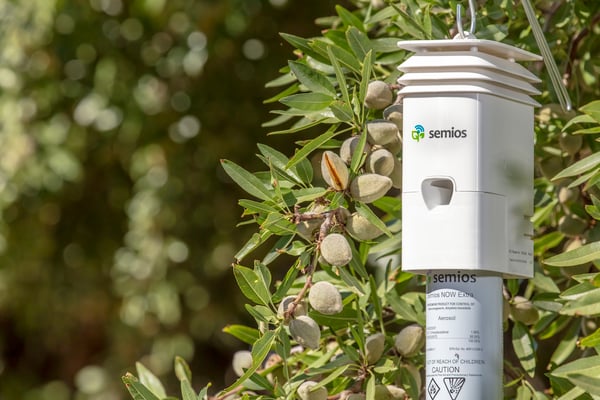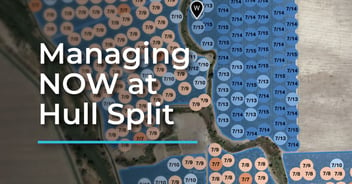Timing Hull Split Navel Orangeworm Sprays for Pollenizers
With nonpareil harvest wrapped up, you may be wondering when to time your navel orangeworm spray for pollenizers. While the UC guideline for the first spray for nonpareils is relatively straightforward, the pollenizer sprays can be tricky to time.
Three factors to consider when planning a pollenizer hull split navel orangeworm spray:
1. Harvest timing relative to pollenizer hull split
The best time to spray according to UC is at 1% hull split. Average predicted hull split dates for most pollinizer varieties are displayed in the table below:
Table 1. Hull split timings for 2020
The 2019 1% regional hull split is also included for consideration in Table 2 below:
Table 2. Hull split timings for 2019
Semios customers can find forecasted hull split dates on a per-acre basis to help plan sprays more accurately.
Looking at the two tables above, it’s interesting to note how much later the 2020 hull split is for the later varieties than in 2019 for the Madera and Kings areas.
If pollenizer hull split is occurring close to an earlier variety’s harvest, a product with a shorter pre-harvest interval may be needed. Pre-harvest intervals and the effective periods for various products can be found on the UC website.
This post on the Almond Doctor also gives a good overview of expected coverage for different products.
Finally, always remember to rotate chemicals. The last thing you want to do is create a resistant population that may overwinter in mummy nuts in your orchard.
2. Tweaking hull split sprays based on navel orangeworm flights
Once you have an idea of hull split dates, sprays for NOW can be adjusted based on when navel orangeworm flight falls relative to pollenizer hull split.
The best way to determine when a NOW flight will occur is to check your egg trap data. Keep in mind that egg traps may not be as effective once hull split has begun, as traps will be competing with split nuts.
The Semios app shows the degree days at the time of capture so that growers and PCAs can easily add degree days to determine when the next navel orangeworm flight is expected.
After nonpareil hull split, the degree-day criteria for navel orangeworm, drops significantly from ~1100 degree days °F to ~750 degree days. This is due to the availability of fresh nutmeat and higher-quality nutrition.
If a flight is near the end of the residual period for the last spray and is a little before the pollenizer hull splits, you may want to consider adjusting your pollenizer sprays to be slightly earlier than 1% hull split to ensure you are hitting peak egg-laying.
3. Post-harvest irrigation
Post-harvest irrigation is very important in almond management. During this time, bud development for next year’s crop is happening, and failing to irrigate effectively can have a negative impact on next year’s yield.
Getting water on nonpareils while planning logistics for spraying pollenizers can be challenging. The Semios platform shows a hull split heatmap (see Image 1 below) to help see variation in hull split dates across blocks. Knowing which sections are splitting earlier than others can give growers and PCAs a good idea of where to start sprays first for maximum efficacy.
Image 1. Hull split heat map on Semios web app
If you have any questions about timing hull split navel orangeworm sprays for pollenizers or the Semios Crop Management Platform, feel free to contact us below!
Resources
The Almond Doctor - Hull Split Sprays for Pollinators
Semios - Navel Orangeworm Management at Hull Split
UCANR - Almond Navel Orangeworm Management
The Almond Board - Research Update
The Almond Doctor - Navel Orangeworm Management at Harvest
Related Posts
Late Spring Almond Irrigation Management
2020 Navel Orangeworm Trap Catch Update
Understanding Variable Rate Mating Disruption
Comparing Degree Day Sources for Navel Orangeworm Flight Prediction




.png?width=352&name=Cumulative%20NOW%20Degree%20Days%20-%20April%201%20Biofix%20(1).png)
